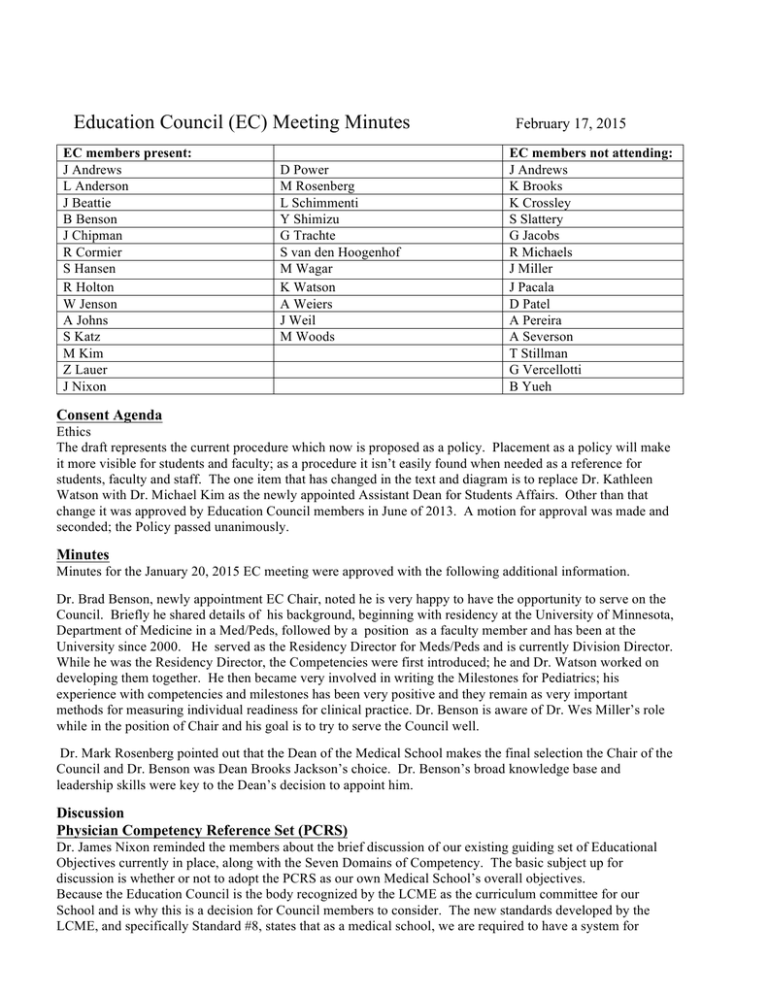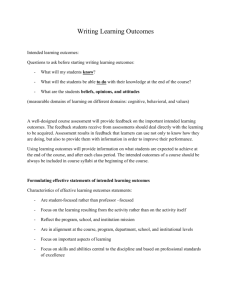Education Council (EC) Meeting Minutes February 17, 2015
advertisement

Education Council (EC) Meeting Minutes EC members present: J Andrews L Anderson J Beattie B Benson J Chipman R Cormier S Hansen R Holton W Jenson A Johns S Katz M Kim Z Lauer J Nixon D Power M Rosenberg L Schimmenti Y Shimizu G Trachte S van den Hoogenhof M Wagar K Watson A Weiers J Weil M Woods February 17, 2015 EC members not attending: J Andrews K Brooks K Crossley S Slattery G Jacobs R Michaels J Miller J Pacala D Patel A Pereira A Severson T Stillman G Vercellotti B Yueh Consent Agenda Ethics The draft represents the current procedure which now is proposed as a policy. Placement as a policy will make it more visible for students and faculty; as a procedure it isn’t easily found when needed as a reference for students, faculty and staff. The one item that has changed in the text and diagram is to replace Dr. Kathleen Watson with Dr. Michael Kim as the newly appointed Assistant Dean for Students Affairs. Other than that change it was approved by Education Council members in June of 2013. A motion for approval was made and seconded; the Policy passed unanimously. Minutes Minutes for the January 20, 2015 EC meeting were approved with the following additional information. Dr. Brad Benson, newly appointment EC Chair, noted he is very happy to have the opportunity to serve on the Council. Briefly he shared details of his background, beginning with residency at the University of Minnesota, Department of Medicine in a Med/Peds, followed by a position as a faculty member and has been at the University since 2000. He served as the Residency Director for Meds/Peds and is currently Division Director. While he was the Residency Director, the Competencies were first introduced; he and Dr. Watson worked on developing them together. He then became very involved in writing the Milestones for Pediatrics; his experience with competencies and milestones has been very positive and they remain as very important methods for measuring individual readiness for clinical practice. Dr. Benson is aware of Dr. Wes Miller’s role while in the position of Chair and his goal is to try to serve the Council well. Dr. Mark Rosenberg pointed out that the Dean of the Medical School makes the final selection the Chair of the Council and Dr. Benson was Dean Brooks Jackson’s choice. Dr. Benson’s broad knowledge base and leadership skills were key to the Dean’s decision to appoint him. Discussion Physician Competency Reference Set (PCRS) Dr. James Nixon reminded the members about the brief discussion of our existing guiding set of Educational Objectives currently in place, along with the Seven Domains of Competency. The basic subject up for discussion is whether or not to adopt the PCRS as our own Medical School’s overall objectives. Because the Education Council is the body recognized by the LCME as the curriculum committee for our School and is why this is a decision for Council members to consider. The new standards developed by the LCME, and specifically Standard #8, states that as a medical school, we are required to have a system for curriculum management and overall objectives for our medical school curriculum. In 2009 and 2010, our medical school adopted the Seven Domains of Competence. These are similar to the ACGME Core Competencies as applied to graduate medical education and the Seven Domains of Competence drive our curriculum. The ACGME doesn’t determine exactly what we have to have as our competencies; these were developed by OME administrators and members of the Council. Our Seven Domains do reflect aspects of the ACGME Core Competencies but are also more specific to our medical student educational program. The development of the Domains was forward looking and fit what has been determined our medical students should be doing. As part of the development those who worked on the Domains looked at 100 medical schools to help establish what seemed to be strong standard of core competencies as a part of standardizing across medical education. Domains of competence are the broad sweeping, overarching areas that should be covered and include patient care, professionalism, practiced based and systems based practice, would define the “good doctor” and these are the areas which we want to use for training and assessing medical students. Areas such as patient care would include ability to take a good patient history, do a good physical, synthesize the data, and develop a strong ability to communicate the diagnosis to peers during case presentation. It is important to consider the courses and the content that would lead students to develop these skills. Components to consider when discussing the Domains of Competence include: • importance of competencies as a focus of the educational program • used to determine what is taught in our classes • what students are assessed on • how well they’ve achieved what is taught Competencies provide the assurance that at the end of their training, through multiple venues, all students are competent in each of these Domains. As students move on to the next level of medical education we can be confident they have been taught to achieve competence in each of these areas and that our students are able to do the things we have determined they should be able to do. With regard to our Domains, there is no requirement that we need to match our competencies to those the AAMC have developed but we do have to map our objectives to comply with the AAMC standards. The area with the largest gap between our Domains of Competence and those of the AAMC is our emphasis on research. The AAMC has not developed this as a targeted competency to train people to understand research. It is covered somewhat in the PBL & I in theirs, but not at the same level. As Dr. Nixon noted the value of having national standards for medical students is that regardless of which residency training an individual selects they will have learned a standardized set of skills linked to the PCRS. The PCRS are the things that should be emphasized in all medical school training programs. Schools are very similar in what is covered but there isn’t broad national set of medical school core competencies. The AAMC development is their step to fill the gaps in medical student training. To maintain compliance with the AAMC requirements we have mapped our objectives to them. The AAMC doesn’t require we adopt them, but doing so is just one more step and the inclusion of those with more specificity is a positive a step. When we adopted our current competencies five or six years ago, they were very forward thinking, the level of similarity illustrates that clearly. There are several new important core competencies included in the AAMC version and overall it includes more up-to-date language that has developed over the last five years. An advantage with regard to the core Entrustable Professional Activity (EPA) for residency, they are mapped to these PCRS. Also using the EPAs as one of the tools to evaluate medical students is currently being considered and would ease transition from medical school to residency. Each of these competencies is mapped to the EPAs. An added advantage is the commonality of language across the medical education continuum; UME, GME and CME. In applying competencies, they fall into specific domains and when talking to a patient all interactions and care requires using knowledge and many of the domains (and competencies) to communicate regarding their health, treatment, care and outcomes. An EPA is the process of putting all of the necessary activities together and determining at what level is the individual (student or resident) able to be trusted at a given point in their training. There are levels of entrustment that teaching faculty can identify to validate the individual’s progress toward completion of their training. Introducing the PCRS while students are in their UME program will make transitioning to residency more seamless. Dr. Nixon noted when introducing the topic it was clear that there are faculty who are not aware of our Competencies which have been in place for 5 years. The goal of the process to develop these Competencies foresaw apparent linkage of the objectives of each course to the overarching set of Competencies. Faculty struggled with why their course objectives should be affected by them, but seeing them mapped, they make sense. Every course has course objectives for every session, faculty are required to review them annually and make adjustments as content may change. Once faculty determine they are up-to-date, the review is completed within Medical Education. The mapping is used to manage the curriculum to ensure the intended content is what is being taught. When the initial work was done by course directors, at both the Duluth campus and at the TC campus, they were asked to provide 3 learning objectives for each session. There were times when there were 20 submitted and those had to be reduced and refined. The process lead to fewer objectives and which developed conceptually. If the residency programs across the country are using the PCRS format for measuring their residents then UMMS wants to be able to hand off students to them with the same language and milestone measures being used in residency programs. It simplifies the handoff and uses the same language for medical students as used in residencies to define where the individual is in achieving their medical education. The PCRS as a national standard is pushing more and more training toward patient care. Council Member Responses • Student specifically asked how they would be impacted by the changes from the current Competencies and those being discussed. • They asked for clarification of the goals in making the change and how its affect could impact day-today in their clinical rotations. • The only drawback is the missing “Scientific and Clinical Inquiry; which can be easily incorporated into the PCRS. • When a student doesn’t score well on the Step Exams or struggle in a clerkship, the PCRS measures allow the teaching faculty to be able to sort out where there are strengths and weaknesses, to provide meaningful feedback. • It would be helpful to understand how the objectives map to the Domains for a practicing physician. • The power for the teaching physician is being able to zero in on a specific skill or characteristic that requires improvement and to tell the student what specifically they need to work on. • If a student or resident can meet all of the specific skills demonstrated in the EPAs then they are meeting the goals of the Domains, this is tied directly to mapping that has been done in their development. • The AAMC development and detailing of the “Interprofessionalism” Domain is a strong and important addition in using the PCRS. • The EPAs will aid in evaluating students more effectively whether in OSCEs or in rotations, especially in understanding why they are strong in some areas but cannot seem to synthesize across the domains. • The new set doesn’t address research and UMMS should insert the “research” language into the PCRS • To achieve “Interprofessional Collaboration” it is important to make it a focus and language should be improved to support that goal. • The “Interprofessional Collaboration” is a new LCME Standard and we will have to meet that Standard, so it should be included as a Domain. One of the Work Groups is working on how to better integrate it into our curriculum. • Make certain UMMS students are prepared and ready to work in team oriented patient care. • Students should understand they will hear this language with regard to EPAs while in rotations and it’s helpful to have familiarity with them for their learning in a team. • To counter act some areas where burnout in healthcare is more prevalent the ability to work in teams is seen as especially important. • Explore how the use of EPAs and the Domains inform the Admission process. To integrate the areas where the UMMS Domains would enhance the PCRS it will be helpful to update the language in the UMMS document and then place them appropriately and as a continuation of the numbering. Do those numbers below adequately address the areas of research and knowledge found in the UMMS Domains? It was suggested to consider the following changes/additions: Knowledge for Practice 2.6 Practice–Based Learning and Improvement 3.10 addresses Research “ It’s important on some level to retain the values placed upon “Science and Clinical Inquiry” when the UMMS Domains were written. With regard to adding language it will be important to remember the AAMC is requiring mapping to the PCRS and any modifications will require double mapping. Other stake holders will include all three curriculum committees (SFC, CEC and CUMED) which will have an opportunity to weigh in on this topic and the Faculty Assembly, so the faculty at large is aware of the change. A motion was duly made and seconded to accept the PCRS as the new UMMS Domains and a recommendation to provide the opportunity for comment by the key stakeholder groups. A final vote will be taken at the March 17, 2015 EC Meeting. The motion was passed unanimously. Next Meeting: April 21, 2015 4-5:30 p.m., B646 Mayo Bldg



